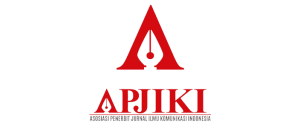STRATEGI KOMODIFIKASI HARIAN RADAR BANTEN
DOI:
https://doi.org/10.30656/lontar.v4i2.331Abstract
Media cetak memiliki peran sebagai penyampai informasi, pendidikan, hiburan, kontrol sosial dan lembagai ekonomi. Pada masa sejarah awal media massa, media lembaga ekonomi tidak menjadi fokus kajian pengamat komunikasi. Karena media hanya dipandang sebagai produk penyampai informasi. Memasuki tahun 1990, dimana media sudah menjadi sebuah industri, faktor ekonomi menjadi kajian khusus. Maka pendekatan ekonomi politik media menjelaskan adanya pertarungan kepentingan ekonomi, politik, dan sosial sebagai bentuk mempertahankan dan meningkatkan kinerja perusahaan. Radar Banten sebagai harian terbesar di Banten dengan oplah 20.000-30 ribu eksemplar berhasil menjadi koran terpercaya, terbesar, dan menjadi rujukan para pengambil keputusan dan masyarakat di Banten. Untuk mengetahui strategi Radar Banten, sebagai pers daerah yang berkembang pesat, dapat menggunakan teori ekonomi politik dengan pendekatan komodifikasi: isi, khalayak, dan sumber daya manusia. Komodifikasi adalah proses transformasi nilai guna menjadi nilai tukar.Penelitian ini menggunakan paradigma kritis dengan pendekatan penelitian kualitatif, metode pengumpulan data menggunakan wawancara dan studi pustaka dengan objek Radar Banten. Bertujuan mengungkapkan strategi komodifikasi yang ditempuh Radar BantenHasil penelitian menunjukkan studi ekonomi politik kritis yang digunakan Radar Banten varian strukturalis, dalam memproduksi berita, mencari iklan, dan mendistribusikan menggunakan aturan yang telah dibakukan. Manajemen Radar Banten tetap bekerja sesuai kaidah-kaidah pengelolaan sebuah suratkabar yang profesional. Namun semua prosedur yang ditetapkan dalam proses pembuatan berita, harus memiliki nilai guna sehingga dapat mengandung nilai tukar. Proses seleksi berita, diarahkan agar berita yang disajikan serta kemasan produk harus menarik dan memiliki nilai jual. Dengan tujuan untuk memenuhi keinginan pemilik modal dan pemasang iklan.Downloads
Published
Issue
Section
License
By submitting an article to the journal, the author(s) agree to transfer the published article's copyright to the journal, which will act as the publisher. This means the journal will have the right to publish the article in various forms, including reprints. The journal will maintain the publishing rights to the published articles.
In line with the license, authors and third parties (readers, researchers, and others) are allowed to share and adapt the material. In addition, the material must be given appropriate credit, provided with a link to the license, and indicated if changes were made. If authors remix, transform, or build upon the material, authors must distribute their contributions under the same license as the original.






